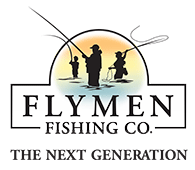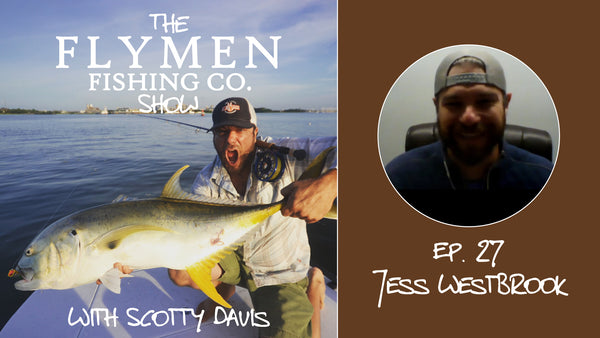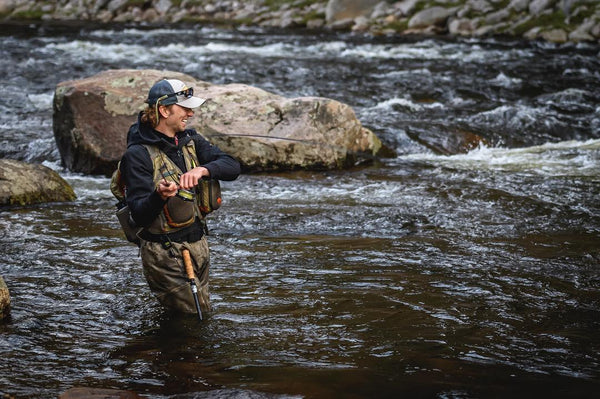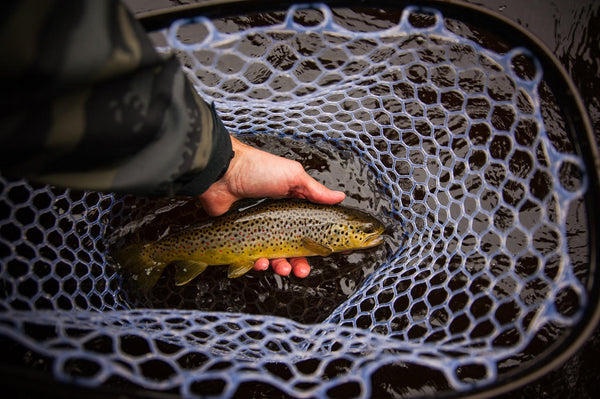Flymen Blog
Fly Tying Kit Tutorial: Fish-Skull Skulpin Bunny
The Ultimate Go-To Trout and Bass Pattern With Irresistible Natural Movement
Learn to tie the Skulpin Bunny in today's fly tying tutorial video using the NEW Skulpin Bunny Fly Tying Kit.
This versatile fly has proven itself on rivers worldwide as a fish magnet. Designed to be fished on the river bottom, the Skulpin Bunny can be dead-drifted or slowly stripped to imitate a sculpin and swims in the hook-up position to avoid snagging.
The Skulpin Bunny swims hook up to avoid snagging on the bottom, shown here swimming in the NEW Fly Tester.
The Skulpin Bunny Fly Tying Kit contains everything you need to tie 6 Skulpin Bunny flies, including step-by-step tying instructions, to make it easy for you to get your hands on the various needed fly tying materials all in one place.
Fly Recipe
- Fish-Skull® Sculpin Helmet
- Fish-Skull® Living Eyes
- Kona® Trout Streamer 4XL (TS4) hook
- Hareline® Cross-Cut Rabbit Strips
- Hareline® Straight-Cut Rabbit Strips
Fly Tying Tutorial: Tradd Little's Neon Caddis
A Good Caddis Pupa Should Be a Staple in Every Trout Angler’s Fly Box
I like Caddis Pupae that are easy to tie, have vibrant colors, and are super quick to drop to the bottom. Tradd Little's Neon Caddis covers all of these bases, and then some.
Tied with a Nymph-Head Evolution tungsten beadhead and the perfectly shaped Kona USP Scud/Pupa hook, this little Caddis Pupa will be all you need.
Fly Tying Tutorial: The Nymph-Head Heavy Metal Perdigon
The Perdigon Has Taken the Euro-Style Fishing World by Storm.
This simple yet very fishy fly has everything that fast-water fly anglers are looking for... An endless choice of colors, instant sinkability, and 1000% bulletproof.
Fish the Heavy Metal Perdigon on its own, under a dry fly, or with a team of other nymphs – just fish it!
Fly Recipe
- Hook: Kona Barbless Jig Hook (BJH), size #10 used in video (sizes can range from #10 - #16)
- Head: Nymph-Head Heavy Metal tungsten bead, size 4.0 mm (5/32") used in video (adjust size to match hook)
- Tail: CDL, Mallard, or any barred feathers.
- Rib: UTC Ultra-Wire
- Body: Flashabou
- Hot-Spot: Orange Thread
- Wing Case: Loon UV Fly Finish BLACK
- Body Coating: Coat the whole fly in Loon UV Thin
Fly Tying Video: The Deer Hair Hot Spot Caddis
This Nymph Is a Great Little Caddis Pupa – With Some Added Flair
Hot spots on nymphs are a great way to not only get the attention of the fish you're targeting, but in certain fishing circumstances they can help you track your fly easier by sight. Most hot spots are made with dubbing that is a different color than the body of the fly, but this fly sets itself apart by using brightly colored deer hair tied on top of the hook as the hot spot.
This technique helps the fly stay upright in the water while the fly gets deep in the water column from the weight of the Nymph-Head Evolution tungsten beadhead.
Recipe
- Hook: Kona Universal Scud/Shrimp/Pupa (USP) hook, size #12
- Head: Nymph-Head Evolution Mayfly Swimmer & Burrower tungsten beadhead, olive, size large
- Rib: Ultra Wire
- Shell Back: Kiley's Exo Skin
- Body: Ice Dub
- Hot Spot: Deer Hair
Fly Tying Tutorial: Chase Howard's Extended Body Drake
Learn To Tie Chase Howard’s Extended Body Drake, a Nymph With Movement That Is Out of This World
Dead drifting this fly into a swing works flawlessly as the Nymph-Head Evolution tungsten beadhead will get the fly deep quick, and as the fly swings, the Wiggle-Tail Shank offers tons of extra movement.
The weight of the bead isn't a compromise for realism as the Evolution Mayfly Swimmer & Burrower tungsten beadhead is molded after the common mayfly swimmer and burrower head profile – oval, elongated, and gracefully curved at the front but flattened at the back near the thorax with prominent, egg-shaped eyes.
We hope you enjoy tying and fishing this fly!
Fly Recipe
Rear
- Rear Shank: Nymph-Head Wiggle-Tail Shank
- Tail: Pheasant Tail
- Wing Case: Pheasant Tail
- Body: Rabbit/Synthetic Dubbing Blend
Front
- Hook: Kona Terrestrial Nymph Dry (TND), size #10
- Bead: Nymph-Head Evolution Mayfly Swimmer & Burrower tungsten beadhead, large, brown
- Connection to Tail Shank: Fluorocarbon Tippet, 2X
- Tail: Soft Hackle
- Wing Case 1: Pheasant Tail
- Body: Rabbit/Synthetic Dubbing Blend
- Legs: Soft Hackle Fibers
- Wing Case 2: Pheasant Tail
- Body: Rabbit/Synthetic Dubbing Blend
- Legs: Soft Hackle Fibers
- Collar: Rabbit/Synthetic Dubbing Blend
3 Simple Tactics for Fly Fishing Pocket Water
Pocket Water Can Be Some of the Most Exhilarating Waters to Fish
What makes a pocket water fishery are the boulders that block the general flow of the river, forming hydro-breaks where fish lie in wait in the darkness, ready to dart at a moment's notice for food.
As a trout guide, I can’t see myself guiding or fishing anywhere else during the peak season but on my home river in the Adirondacks, the West Branch of the Ausable. Here are some tactics I've picked up from guiding and fishing these waters that may help you next time you're on the water.
Small Stream Fly Fishing Tactics
Fly fishing small streams for wild trout is without question my favorite piscatorial endeavor.
Aside from the lack of crowds, the gorgeous surroundings, and the all-too-eager trout, small streams offer endless learning opportunities. The lessons garnered from creeks, streams, and brooks can be applied to all aspects of trout fishing.
The following are a few of the tactics I have learned from my experience on smaller waters that I fish frequently both on my own and when guiding clients as well.
The Art of Stripping Streamers: Fly Fishing Tactics
You have the fishing reports, a spanking new streamer outfit, and a leave pass to go chase some predators.
Your fly boxes are crammed full after hours watching videos while tying at the vise — heck, you probably know more about Brian Wise’s hands at this stage than his wife does.
Flies, lines, and water are all essential tools, but it's not going to work out if you can’t make those bugs swim.
When the Flymen crew asked me to work up another streamer piece for the blog I went back to my 2016 article, “Beyond Banging The Banks”. What we didn’t cover was how to make that fly swim when it hits the water. Consider this Chapter 2.
Trout Fly Fishing: 3 Bad Habits to Break
As a trout guide I like to think that there are no mistakes in fly fishing, rather there are learning opportunities — lots and lots of learning opportunities.
With each client I try to place an emphasis on proving yourself wrong, and by that I mean, take some rule/tactic/method and try to disprove it. After all, how many times have you done what was considered to be wrong and yet still caught a fish?
Habits on the other hand, are another story. Unlike mistakes, habits — especially a certain few — can be detrimental to catching trout. I'm going to address three of the worst habits I see on the water and how you can go about improving your habits to catch more trout.
Two-Handed Fly Fishing For Bull Trout: Setup, Methods, Flies, Locations
As fly anglers, we find ourselves constantly pushing the limits of innovative techniques.
One such method, two-handed casting (better known as spey casting), has exploded in popularity in the last five years, though some would say ten years or so. For those who don’t know, spey casting is generally done to target anadromous fish with a much less-tiring casting stroke, capable of handling larger flies and sinking tips with relative ease.
- Previous
- Page 1 of 2
- Next
- Previous
- Page 1 of 2
- Next























